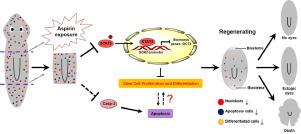Aquatic Toxicology ( IF 4.1 ) Pub Date : 2022-04-10 , DOI: 10.1016/j.aquatox.2022.106158 Ang Liang 1 , Fan Wu 2 , Chaojie Li 2 , Yiyang Yu 3 , Zimei Dong 2 , Guangwen Chen 2 , Fei Yu 2 , Yanqing Yuwen 2 , Dezeng Liu 2

|
As a widely used drug in clinical practice, aspirin has a large number of residual drugs and metabolites discharged into the environment during the pharmaceutical process or after taking the drug. Aspirin content and its metabolite, salicylic acid, have been reported and detected in several river water samples and municipal wastewaters. However, little is known about the toxicity mechanisms of this drug in aquatic invertebrates. In this study, we examine the toxic effect and investigate the toxicity mechanism of aspirin in planarian, which own the excellent regeneration and sensitive toxicity detection ability. Planarian is treated with 0.7 mM aspirin for 6 h, 48 h, 3 d and 5 d, and the mRNA and protein expression levels of the stem cells markers, in parallel with the target genes of the signaling pathway are analyzed by RT-qPCR, whole-mount immunofluorescence, and Western blot. The results show that aspirin strongly inhibits stem cell proliferation and causes retarded blastemas growth in planarians. Furthermore, the mRNA and protein expression levels of stem cells markers and the target genes dramatically decrease after the aspirin treatment. Meanwhile, the expression level of apoptotic cells also shows a downward trend. Their significant and coincident downregulations after the aspirin treatment suggest that aspirin regulates planarian regeneration via STAT3/SOX2/OCT4 signaling pathway. Our work reveals the toxicological effect and the mechanism of aspirin to the planarian, and provides basic data for therapeutic applications of aspirin in regeneration and warns about the ecological damage of aspirin abuse.
中文翻译:

阿司匹林通过STAT3/SOX2/OCT4信号通路抑制淡水杜吉鱼再生过程中的干细胞增殖
作为临床上广泛使用的药物,阿司匹林在制药过程中或服药后有大量残留药物和代谢物排放到环境中。阿司匹林含量及其代谢物水杨酸已在多个河水样品和市政废水中得到报告和检测。然而,关于这种药物在水生无脊椎动物中的毒性机制知之甚少。在这项研究中,我们研究了阿司匹林对涡虫的毒性作用并探讨其毒性机制,其具有优异的再生和灵敏的毒性检测能力。涡虫用 0.7 mM 阿司匹林处理 6 小时、48 小时、3 天和 5 天,通过 RT-qPCR 分析与信号通路的靶基因平行的干细胞标志物的 mRNA 和蛋白质表达水平,全贴装免疫荧光和蛋白质印迹。结果表明,阿司匹林强烈抑制干细胞增殖并导致涡虫的胚泡生长迟缓。此外,在阿司匹林治疗后,干细胞标志物和靶基因的 mRNA 和蛋白质表达水平显着降低。同时,凋亡细胞的表达水平也呈下降趋势。它们在阿司匹林治疗后显着且同时发生的下调表明阿司匹林通过 STAT3/SOX2/OCT4 信号通路调节涡虫再生。我们的工作揭示了阿司匹林对涡虫的毒理学作用和作用机制,为阿司匹林在再生方面的治疗应用提供了基础数据,并对滥用阿司匹林的生态破坏提出了警告。结果表明,阿司匹林强烈抑制干细胞增殖并导致涡虫的胚泡生长迟缓。此外,在阿司匹林治疗后,干细胞标志物和靶基因的 mRNA 和蛋白质表达水平显着降低。同时,凋亡细胞的表达水平也呈下降趋势。它们在阿司匹林治疗后显着且同时发生的下调表明阿司匹林通过 STAT3/SOX2/OCT4 信号通路调节涡虫再生。我们的工作揭示了阿司匹林对涡虫的毒理学作用和作用机制,为阿司匹林在再生方面的治疗应用提供了基础数据,并对滥用阿司匹林的生态破坏提出了警告。结果表明,阿司匹林强烈抑制干细胞增殖并导致涡虫的胚泡生长迟缓。此外,在阿司匹林治疗后,干细胞标志物和靶基因的 mRNA 和蛋白质表达水平显着降低。同时,凋亡细胞的表达水平也呈下降趋势。它们在阿司匹林治疗后显着且同时发生的下调表明阿司匹林通过 STAT3/SOX2/OCT4 信号通路调节涡虫再生。我们的工作揭示了阿司匹林对涡虫的毒理学作用和作用机制,为阿司匹林在再生方面的治疗应用提供了基础数据,并对滥用阿司匹林的生态破坏提出了警告。阿司匹林治疗后干细胞标志物和靶基因的mRNA和蛋白质表达水平显着降低。同时,凋亡细胞的表达水平也呈下降趋势。它们在阿司匹林治疗后显着且同时发生的下调表明阿司匹林通过 STAT3/SOX2/OCT4 信号通路调节涡虫再生。我们的工作揭示了阿司匹林对涡虫的毒理学作用和作用机制,为阿司匹林在再生方面的治疗应用提供了基础数据,并对滥用阿司匹林的生态破坏提出了警告。阿司匹林治疗后干细胞标志物和靶基因的mRNA和蛋白质表达水平显着降低。同时,凋亡细胞的表达水平也呈下降趋势。它们在阿司匹林治疗后显着且同时发生的下调表明阿司匹林通过 STAT3/SOX2/OCT4 信号通路调节涡虫再生。我们的工作揭示了阿司匹林对涡虫的毒理学作用和作用机制,为阿司匹林在再生方面的治疗应用提供了基础数据,并对滥用阿司匹林的生态破坏提出了警告。它们在阿司匹林治疗后显着且同时发生的下调表明阿司匹林通过 STAT3/SOX2/OCT4 信号通路调节涡虫再生。我们的工作揭示了阿司匹林对涡虫的毒理学作用和作用机制,为阿司匹林在再生方面的治疗应用提供了基础数据,并对滥用阿司匹林的生态破坏提出了警告。它们在阿司匹林治疗后显着且同时发生的下调表明阿司匹林通过 STAT3/SOX2/OCT4 信号通路调节涡虫再生。我们的工作揭示了阿司匹林对涡虫的毒理学作用和作用机制,为阿司匹林在再生方面的治疗应用提供了基础数据,并对滥用阿司匹林的生态破坏提出了警告。











































 京公网安备 11010802027423号
京公网安备 11010802027423号